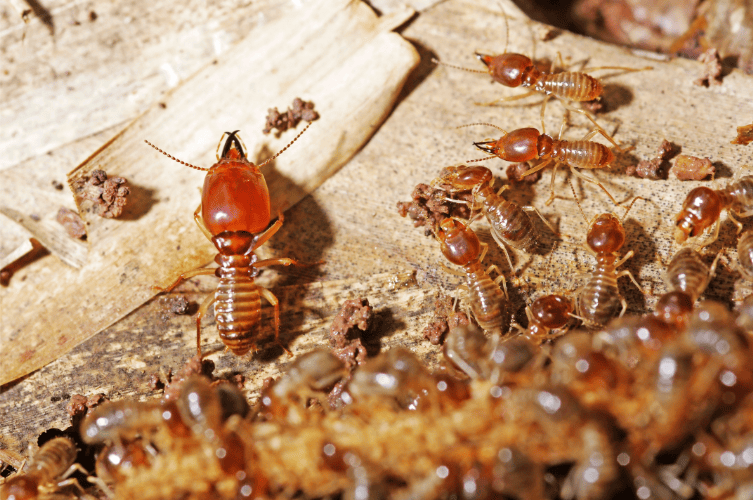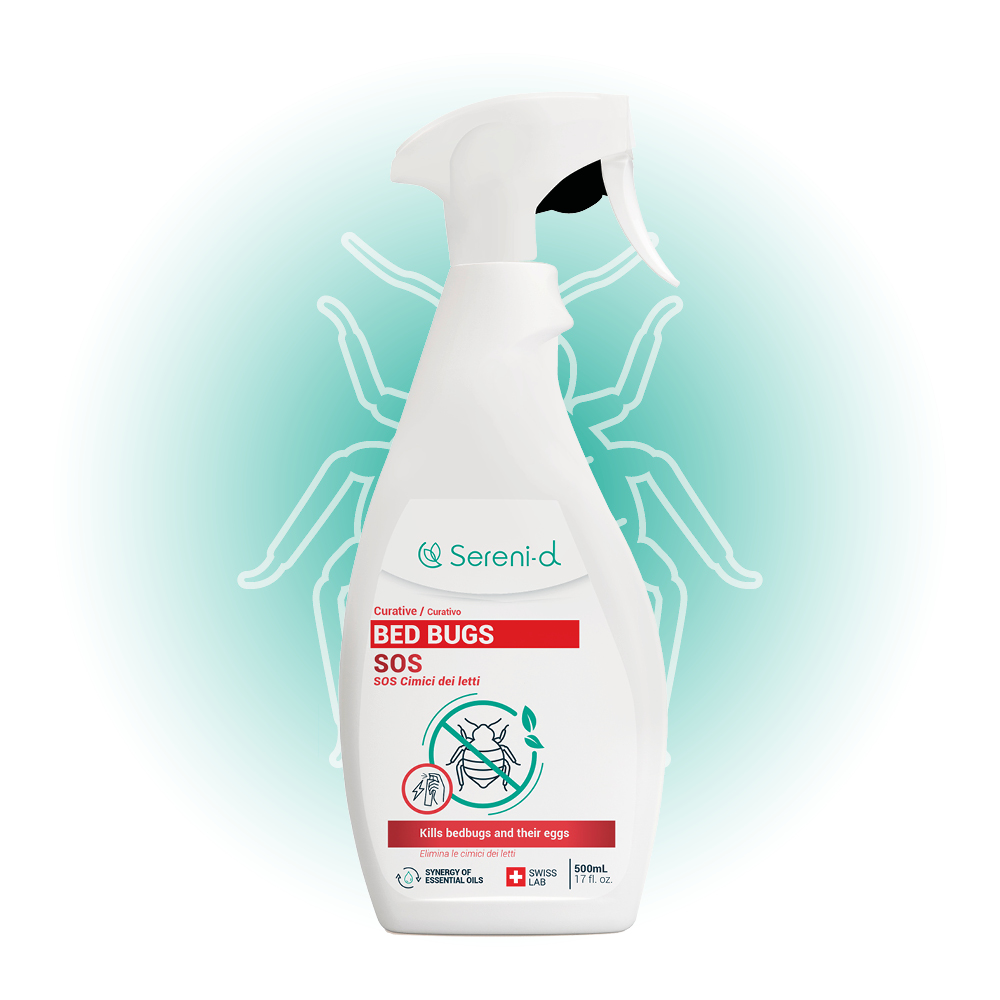Des chiens pour détecter les punaises de lit ? Méthode à première vue surprenante, la détection canine a pourtant fait ses preuves et est régulièrement utilisée par les professionnels de la lutte contre ces nuisibles. Fonctionnement, précautions à prendre, tarifs, choix du prestataire, voici tout ce qu’il faut savoir sur le sujet.
Les informations clés
- La détection canine des punaises de lit est une méthode fiable à + de 95%.
- Elle peut être réalisée en prévention, en détection et après un traitement.
- Les chiens doivent être spécialement entrainés pour cette tâche, la race est indifférente.
- Le tarif va de 170 € à plus de 500 € en fonction de la surface du logement.
- Privilégier les professionnels membres du SEDCP : Syndicat des Experts en Détection Canine des Punaises de lit.
- Priviligier les professionnels ayant obtenu la certification bureau veritas “VALIDÉ RECONNAISSANCE PUNAISE EXPERTISE” . C’est le cas d’ECOFLAIR, une entreprise pionnére en France.
Comment le chien peut détecter des punaises dans le lit ?
Le pouvoir exceptionnel de l’odorat canin
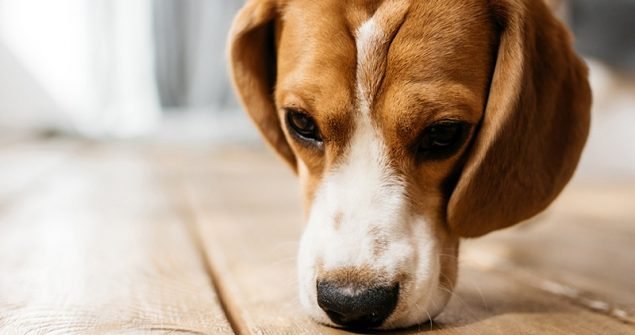
Le nez du chien est de 100 000 à 1 million de fois plus sensible que celui de l’Homme.
Grâce à leur odorat exceptionnellement développé, les chiens détecteurs sont capables de repérer des punaises de lit même dans des zones difficiles d’accès comme les coutures des matelas, les fissures des plinthes, les interstices des sommiers et des têtes de lit. Les punaises de lit dégagent une odeur distincte, principalement composée de phéromones et d’autres composés chimiques que les humains ne peuvent pas percevoir, mais que les chiens sont capables de détecter même à des concentrations extrêmement faibles.
Un entraînement spécifique pour les chiens détecteurs
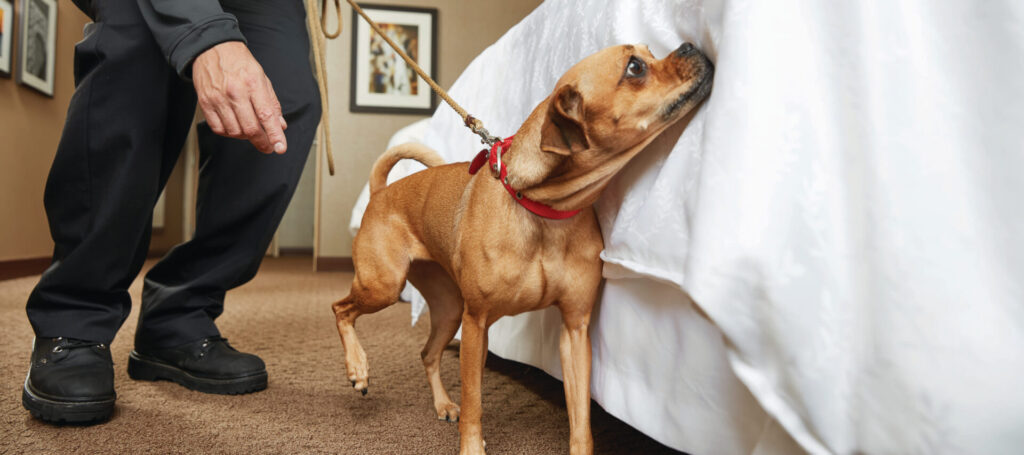
Les capacités olfactives innées des chiens ne suffisent pas. Un entraînement rigoureux est nécessaire pour en faire des chiens détecteurs de punaises de lit. En pratique, ils sont habitués à associer l’odeur distinctive des punaises de lit à une récompense (nourriture ou jeux), ce qui les motive à rechercher activement ces nuisibles. Ils sont ensuite mis en situation réelle dans des habitations ou des locaux à la recherche de signes d’infestation. Après une formation intensive du chien, il devra être formé de nouveau toutes les 6 semaines afin de maintenir de hautes compétences de détection. Les chiens de détection sont des animaux de compagnie avec qui une très bonne entente avec leur maître est nécessaire. Ils doivent être sociables pour être efficaces.
La détection canine est-elle efficace ?
Oui, grâce à leur odorat ultra-développé, les chiens peuvent non seulement détecter les punaises de lit vivantes, mais aussi localiser les zones où ces nuisibles ont laissé des traces, facilitant ainsi une désinsectisation plus ciblée et efficace. Le chien doit s’approcher à 10 cm de la punaise de lit ou de l’oeuf pour sentir l’odeur de phéromone si l’infestation est faible.
La méthode est régulièrement utilisée par les particuliers, professionnels du tourisme, bureaux d’entreprises, hôpitaux, etc.
Contrairement à l’inspection humaine, qui peut nécessiter de démonter des meubles ou d’utiliser des outils spécifiques pour inspecter les zones difficiles d’accès, un chien peut parcourir une pièce rapidement et identifier les zones infestées sans perturber l’environnement. De plus, cette méthode est non invasive et évite l’utilisation précoce de produits chimiques (aérosols, etc.).
Cette méthode permet aux propriétaires ou aux professionnels de prendre des mesures immédiates pour traiter l’infestation et prévenir sa propagation.
Dans le cas des cinémas, cela permet de détecter exactement les sièges infestés et ne pas avoir à traiter la salle en entier, ce qui serait trop coûteux.
➡️ À lire aussi : Punaises de lit et animaux : ce qu’il faut savoir
Comment se passe une détection canine ?
La détection canine des punaises de lit est une procédure méthodique qui implique la collaboration entre un chien spécialement entraîné et son maître-chien. Chaque dresseur dresse son chien à sa manière. Le caractére de l’animal est pris en compte. En principe, les entrainements se font tous les jours. Le chien est entrainé pour marquer uniquement les punaises de lit vivantes et non pas celles qui sont mortes, les mues et les déjections.
Préparation de l’intervention
Avant l’arrivée du chien, il est recommandé de préparer la zone à inspecter pour maximiser l’efficacité de la détection. Vous pouvez :
- Dégager les pièces : Retirez les objets encombrants ou les piles de vêtements qui pourraient gêner l’accès aux zones à inspecter. Les meubles doivent être placés de manière à permettre au chien de circuler librement.
- Éviter les odeurs fortes : Les produits chimiques, les parfums, les huiles essentielles ou les désodorisants peuvent perturber l’odorat du chien.
- Ne pas utiliser des produits naturels comme la terre de diatomée.
- Limiter les distractions : Assurez-vous que la pièce est calme et sans distractions pour que le chien puisse se concentrer sur sa tâche. Éloignez les autres animaux de compagnie et les enfants.
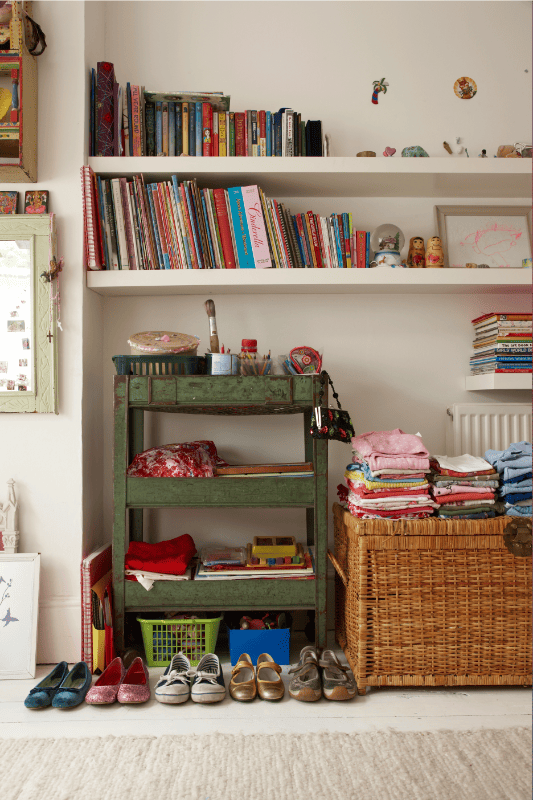
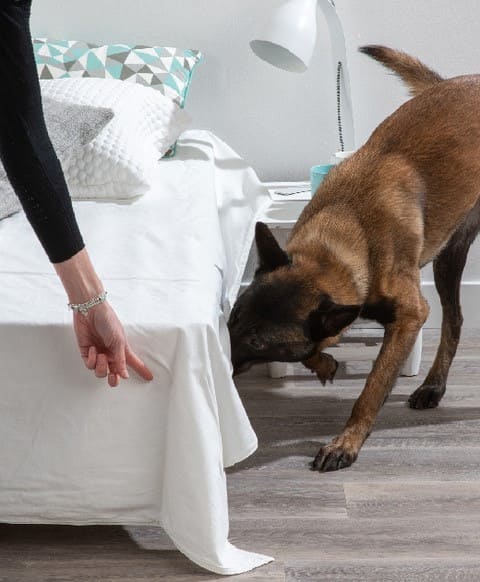
L’inspection par le chien
Une fois sur place, le maître-chien fait le tour de la zone avec son chien détecteur.
Le chien commence à renifler les zones susceptibles d’abriter des punaises de lit, notamment :
- Les lits et la literie : matelas, sommiers, oreillers et têtes de lit, où les punaises de lit ont tendance à se cacher.
- Les meubles : Les coutures des canapés, les tiroirs et les meubles rembourrés sont également examinés.
- Les fissures et recoins : Les plinthes, les fissures dans les murs et les prises électriques sont des cachettes courantes pour les punaises de lit.
- Les textiles et bagages : Les sacs, valises, et autres objets personnels sont également inspectés, surtout si une infestation est suspectée après un voyage.
Lorsqu’il détecte l’odeur des punaises de lit, le chien va réagir d’une façon spécifique, par exemple en s’asseyant ou en grattant légèrement l’endroit où il perçoit leur présence. Ce signal permet au maître-chien de marquer les zones à risque pour une inspection plus approfondie.
Confirmation et rapport d’intervention
Après que le chien a signalé les zones suspectes, le maître-chien procède à une vérification visuelle (détection de traces de sang, etc) ou utilise d’autres outils pour confirmer la présence de punaises de lit. Si des punaises ou des œufs/larves sont trouvés, une intervention de désinsectisation sera recommandée.
Le maître-chien fournit ensuite un rapport détaillé sur la présence d’un nid et les zones infestées, accompagné de recommandations pour le traitement.
Ce rapport est indispensable pour planifier l’étape suivante : intervention chimique, thermique ou mécanique pour éradiquer les punaises de lit.

Quelle est la durée d’une intervention de détection canine ?
En général, une inspection complète peut durer de 30 minutes à plusieurs heures pour une maison ou un établissement plus grand comme un hôtel. Un chien ne doit travailler que 4 à 5 h maximum par jour, par sessions de 45 minutes, entrecoupées par des repos de 45 minutes. S’ils sont trop fatigués, il y a des risques de faux positifs, le chien aura tendance à faire des faux marquages pour terminer son travail rapidement.
Une détection canine en vidéo
Nous remercions la société Oh-Uc pour leur démonstration.
Quand faire appel à une société de détection canine ?
La détection canine des punaises de lit consiste à utiliser des chiens renifleurs spécialement formés pour détecter la présence de punaises de lit dans les habitations et autres lieux, comme des hôtels ou des cinémas par exemple.
La détection canine peut être réalisée en prévention, en détection et après un traitement.
Les chiens interviennent pour du préventif, en cas de suspicion ou pour faire un diagnostic.
- Un particulier pourra avoir besoin de réaliser une détection canine s’il a un doute ou après un traitement pour confirmer sa réussite.
- Un hôtel pourra utiliser cette méthode en prévention 2 fois par an environ.
- Un bailleur pourra lui réaliser un diagnostic entre deux locataires.
⚠️ Après un traitement, il faut attendre 2 semaines pour ne pas mettre le chien en danger. Le temps que les punaises de lit mortes n’aient plus les odeurs des substances actives chimiques.
Quel est le prix d’une intervention de détection canine pour les punaises de lit ?
Tarifs moyens détection canine pour les particuliers :
| Surface à détecter | Tarif moyen |
|---|---|
| 0 à 30 m² | 170 € |
| 30 à 60 m² | 200 € |
| 60 à 90 m² | 250 € |
| 90 à 120 m² | 275 € |
| 120 à 150 m² | 305 € |
| 150 à 180 m² | 330 € |
| 180 à 210 m² | 350 € |
| 210 à 240 m² | 350 € |
| 240 à 270 m² | 370 € |
| 270 à 300 m² | 390 € |
Une vérification visuelle est indispensable pour confirmer la présence de punaises de lit.
Bon à savoir : en cas d’apparition de punaises de lit 15 jours après le passage du chien, le prestataire doit idéalement proposer une nouvelle détection gratuitement.
Tarifs moyens de détection canine pour les professionnels :
- Hôtels et chambres d’hôtes : Environ 200 €/ chambre.
- Bureaux/open space : variable en fonction du m².
- Cinémas : de 450 à 800 € en fonction du nombre de sièges.
Choisir un professionnel de confiance
➡️ Vous pouvez retrouver une liste de prestataires fiable sur le SEDCP : Syndicat des Experts en Détection Canine des Punaises de lit.
Privilégiez les professionels affichant le logo ci-contre.
Ce gage de qualité donné par le bureau Veritas garantit que les experts diagnostiqueurs sont formés et les chiens détecteurs testés régulièrement.
Par ailleurs, voici d’autres conseils :
- Transmission d’un rapport d’intervention complet
- Demande d’une preuve visuelle de la présence de punaises de lit (photos, vidéos, etc.)
- Rester dans la pièce pendant l’intervention du chien
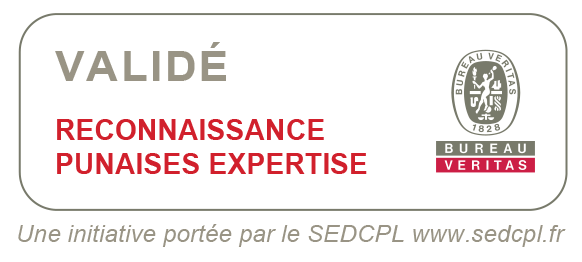
La société ECOFLAIR
Depuis 2010, Ecoflair est une entreprise pionnére dans la lutte contre les punaises de lit en France. Ses équipes d’experts sont certifiés INELP, un certificat de Formation reconnu par le Ministère du Logement et de la Transition Ecologique.
Les experts proposent une offre de services très compléte :
- Détection canine
- Prévention
- Traitement
- Formations
Détection canine : efficace pour d’autres insectes nuisibles ?
La réponse dépend du type d’insecte et de l’entraînement spécifique du chien.
Les chiens peuvent être entraînés à détecter une variété d’insectes nuisibles comme les :
- Termites
- Cafards
- Fourmis charpentières
L’efficacité de la détection canine dépend de la capacité des animaux à être entraînés à reconnaître l’odeur spécifique d’un insecte. Les insectes qui ne dégagent pas une odeur distincte ou qui vivent dans des environnements où d’autres odeurs dominent peuvent être plus difficiles à détecter.
